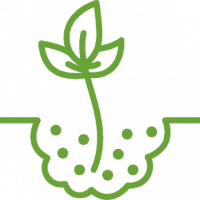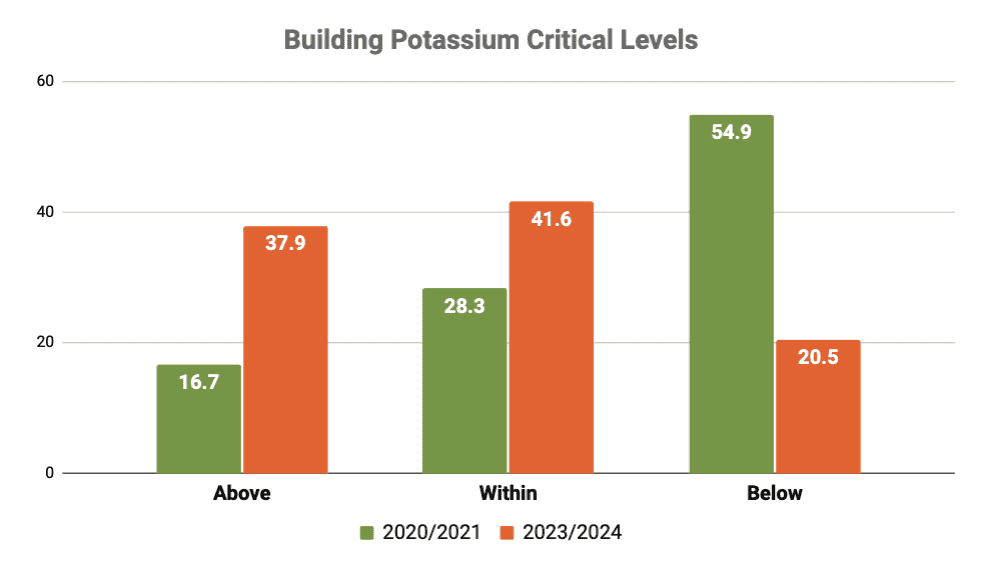Highlights
- Using outdated, traditional nutrient management recommendations leads to over-application of costly nutrients in some areas and under-application in other areas. This wastes money and leaves potential yield gain unrealized.
- Using traditional nutrient management methods and applying the same rate over the entire acre could result in an over-application of $30-$40 per acre. In a 1,000-acre farming operation, that’s $30,000 to $40,000 wasted in over-applied nutrients.
- Advanced Agrilytics’ data-driven, multi-layered spatial analysis creates a custom nutrient prescription that minimizes nutrient waste while boosting P and K efficiency and yield potential.
- The Advanced Agrilytics methodology considers several additional factors at the sub-acre level, such as water movement, soil moisture and landscape topography – all of which affect nutrient availability and uptake.
What a Difference a Year (or Two) Makes
The record-setting farm income levels of 2021 and 2022 are in the rear window, along with $6 corn and $14 soybean prices. With today’s tighter profit margins, it’s never been more critical to get the optimum ROI on every dollar you spend.
One key barrier for many growers is the use of outdated, traditional nutrient management recommendations. These recommendations are based on decades-old, static critical level calculations developed in the late 1950s.
There’s a better way to get more performance out of your phosphorus and potassium, Dr. Kess Berg, Chief Innovation Officer at Advanced Agrilytics, explains.
“When you consider something as simple as a P or K recommendation that many of us practice throughout the Midwest, none of those traditional methods or critical level recommendations take into account the moisture content of the soil throughout the growing season,” he says.
“That’s what makes our approach different and much more effective in terms of getting the right amount of nutrient in exactly the right place, so growers get the optimum performance from their nutrient inputs.”
The unique Advanced Agrilytics methodology starts by dividing acres into small, hexagrid segments – approximately 70 per acre. Then, we use our patented spatial analysis technology to examine multiple mechanisms and other factors within the soil, all of which affect nutrient availability and uptake at that sub-acre level. Some of the sub-acre environmental factors we analyze include:
- Soil mineralogy
- Physical properties of the soil
- Landscape position (slope/topography)
- Soil moisture availability and movement (more about this in a moment)
- Nutrient removal statistics at the sub-acre level

We combine these “layer by layer” findings into what we call a Spatial Critical Level calculation. This, in turn, allows us to create a customized nutrient prescription so that growers can reallocate their P and K, applying higher rates of nutrients where they will provide the greatest ROI and lower rates where extra nutrients are not needed.
Water (Movement) is the Key to Better P & K ROI
Understanding where and how water moves onto and off of each sub-acre is at the very heart of improved P and K efficiency. Why? Because soil moisture affects diffusion – and plants like corn and soybeans get a very high percentage of their P and K (93% and 85%, respectively) through the mechanism of diffusion.
"Understanding the environment of the sub-acre allows us to be more proactive in a management plan and in how we approach that crop and acre throughout the growing season."
Dr. Kess Berg

What is diffusion?
Diffusion is the net movement of nutrients from a region of higher concentration to a region of lower concentration. It’s how relatively immobile nutrients like P and K get from the soil to the root hairs of plants. As plants absorb nutrients in their root zones, the concentration of those nutrients around the roots decreases, causing more nutrients from areas of higher concentration in the surrounding soil to diffuse toward the roots.
Research shows that there is a powerful correlation between water availability and diffusion:


“Water-limited environments are acres that the industry has typically told the grower to ‘give up on,’ meaning lowering inputs and ultimately reducing yields even further,” explains Berg. “When you have fewer than 25 parts per million of phosphorus on a water-limited acre, the grower has only a 50/50 chance of reaching a yield of 200 bushels per acre. When soils contain more than 25 parts per million of phosphorus, the odds of achieving a 200 bushel-per-acre yield increase to 75%.”
Almost every growing season, we experience periods of reduced moisture availability. In the early part of the growing season, it’s a race to get P & K in the plant, particularly on the high ground where water limitations are often a serious risk. However, what if we could reallocate our P & K investment dollars by putting higher concentrations of nutrients in environments with lower diffusion rates (high ground), and lower concentrations of nutrients in environments with higher diffusion rates (low ground)? Then when we do receive soil moisture, we can make more efficient use of our fertilizer placement and move a tremendous amount of nutrients to the roots before the water-limited acres dry out again.
“A grower may not have the capability to do variable rate nitrogen or variable rate seed, but most growers do have the capability to do variable rate applications with their P and K,” says Berg. “Making sure you are getting the precise nutrient concentration at the precise location for optimum nutrient efficiency makes everything about that plant more efficient. How that plant uses nitrogen, how that plant optimizes a fungicide application – it all becomes more efficient with optimized P and K availability.”

Less Waste + More Bushels = Better Profitability
As they say, the numbers don’t lie: Currently, MAP is approximately $700/ton, and potash is approximately $400/ton. Using traditional nutrient management methods and applying the same rate over the entire acre could result in an over-application of $30-$40 per acre. In a 1,000-acre farming operation, that’s $30,000 to $40,000 wasted in over-applied nutrients.
In addition, these outdated methods could result in under-applying nutrients in other areas of the acre, leaving bushels of potential yield unrealized. Our data shows:

Conclusion
That’s why Advanced Agrilytics goes beyond traditional critical level recommendations to calculate a spatial critical level value for each sub-acre in the field. That allows us to create much more precise nutrient application recommendations, which increases nutrient use efficiency and improves yield consistency across all acres. The multi-year results of this “environmental adjustment” have positively influenced yield, particularly on acres that have been a net loss to the operation.
Are you ready to bring your nutrient management strategy into the 21st century by using your fertilizer investment dollars most efficiently while maximizing productivity? For more agronomic insights and to learn more about how to get the most out of each and every acre you farm, visit advancedagrilytics.com.